
|   |

|   |
Nrityavadhana - Bhramari Shivaprakash e-mail: bhramarisrao@yahoo.com July 13, 2013 A dance workshop back in 1997 was a thrilling turning point in my life as a Bharatanatyam performer and practitioner. Likewise, the workshop organized by the Karnataka Sangitha Nrithya Academy was an eye opener to at least some of the 84 who attended from different parts of Karnataka and also neighboring Chennai. It was a 5-day workshop called ‘Nrithyavadhana’ conducted with the intention of introducing to the dance students/teachers, the academic aspects of the performing art world along with performance. The students had to choose one among Bharatanatyam, Kuchipudi and Kathak. The whole idea was the brain child of Kuchipudi dancer Vyjayanthi Kashi who is currently the president of the academy. The day was divided into practice session, theory session and demonstration/performance session. Unlike other workshops, importance given to theory sessions made this workshop unique. Resource persons were Padmini Ramachandran - Bharatanatyam, Lakshmi Rajamani - Kuchipudi, Jayanti Ishvaraputhi - Kathak, Mamatha Hasan - Yoga, Indira Kadambi - abhinaya, Nandini Ishvar, Dr. Karuna Vijayendra, Prof. ML Samaga who handled the theory sessions. 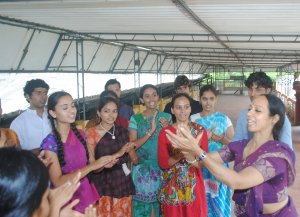
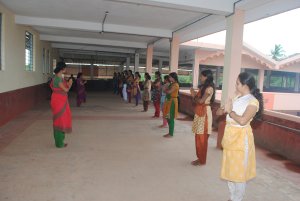
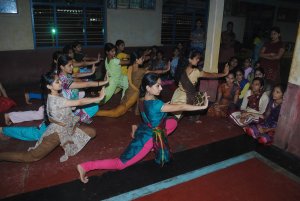
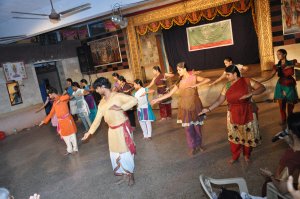
The tuition, accommodation and food were free. The venue, food and hospitality were courtesy Patel Venkatesh Rao and Harikrishna Punaroor, managing trustees of Sri Vishvanatha Svami Temple, Punaroor. An ideal location for a peaceful learning amidst nature, Punaroor is a small town in Udupi district. At 7am in the morning attendees would start the day with a yoga session. Students were told about the importance of regular asana practice and pranayama. Some asanas were suggested to the students based on their complaints about pain in back, knees and ankles. Bharatanatyam students were taught a padavarna in raga Kamach and adi tala, and also a javali composed by Pattabhiramayya. When we watched the final day’s performance, one thing was sure that manodharma abhinaya can flourish only when the basics of the abhinaya technique is profound. Kuchipudi students were taught a prayer shloka, Annamacharya’s Dashavathara kirthane and Sharada pravesha daru. Kathak aspirants were introduced to the patterns of tihai, thukudas, ladis etc of teen taal. Karnataka is not much exposed to Kathak except Bangalore (because of Guru Maya Rao). Time factor is a major constraint to introduce a completely new dance technique. Jayanthi Ishvaraputhi was successful in inspiring a few among them to pursue Kathak full time. 

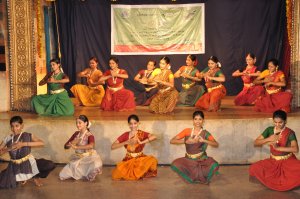
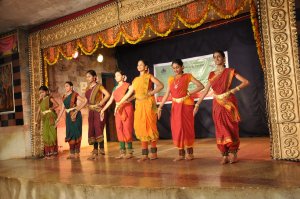
Even though Bharatanatyam is the most commonly practiced art form in Karnataka, the response from the aspirants to learn Kuchipudi and Kathak was highly encouraging. They were introduced to the desi aspects of these styles from a beginner’s perspective. In the evening’s lec/dem sessions, Padmini Ramachandran reminisced about how she started learning with Guru Vazhavoor Ramaiah Pillai. She also demonstrated her way of interpretation of nayika oriented items by a male dancer. Lakshmi Rajamani demonstrated how Kuchipudi dance style evolved from Sanskrit period to the times when Telugu language developed. She even danced for a few items exactly the way she was taught by her Guru Vedantham Prahlada Sharma. We could see a clear cut difference in the olden day practice and the modern day practice. Jayanthi Ishvaraputhi’s passion for Kathak made her pursue this art form for a rigorous training of 11 years under renowned guru Pt Birju Maharaj whom she approached thinking that 6 months would be enough to learn Kathak for one who already knew an art form (Bharatanatyam). The experience she shared helped us to understand the definition Bharatamuni states for “Margi” and Desi” in his Natya Shastra. The theory sessions were also interesting as Dr. Karuna Vijayendra talked to the students about the evolution and development of dance traditions in India. The technique of initiating the students to answer her question, in turn getting them to her point of discussion was very much appreciated by the students for whom usually theory sessions are boring. Nandini Ishvar demonstrated the karanas and angaharas. Prof. ML Samaga, an English professor and a Yakshagana artist/scholar, had an interactive session to explain the importance of “effective communication or abhinaya” which is the core requirement in all the performing art forms of India. Nrithyavadhana workshop was a major contribution of the president Vyjayanthi Kashi and all her officials at the Karnataka Sangitha Nrithya Academy in the following points. * All the art related government aids/grant programs till now centered in and around Bangalore moved out and came to Punaroor. * The attendees were not only dance students, but also teachers, performers, choreographers etc * 3 different art forms were taught along with yoga, theory and lec/dem sessions. As we all know about the unstable ruling Government in Karnataka, we hope that Vyjayanthi Kashi will get to complete her term of 3 years at the academy to come up with many more successful projects for the sake of Indian art and the artistes. Bhramari Shivaprakash runs the Nadanrithya School of Dance in Mangalore. |